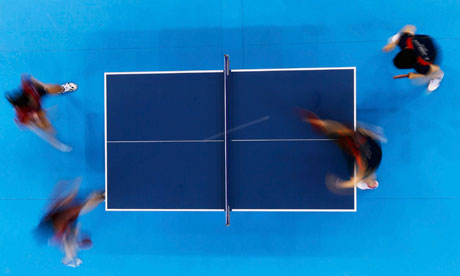
Introduction
Pick-pock. Pick-pock. Pick-pock. Gasp! Pick-pock. Pick-POCK! Applause. That's how a typical point in professional table tennis sounds. It's a story of unbelievably quick thrust and counter-thrust, of desperate defence morphing into furious attack and back again, all conducted with the purposeful delicacy of a surgeon attempting a personal best.
This, on the other hand, is how a typical point in beginner's table tennis sounds: Pick- pickpickpickpickpick. I'll get it. It went down the side I think. It's nearer to you. If you push it with your feel I can juusssst – ow! It's OK, my back again. Anyway, I've got it. Was I serving on the forehand side? What's the score? It's the first to how many? Oh God, let's go home.
Never fear, though: the learning curve isn't the steepest, and soon you'll be conducting rallies of your own – albeit at slightly less death-defying speeds.
Still, it never gets easier chasing down those little white balls.
The basics
A game for two or four (or many more, if you're playing round-the-table in a pub), table tennis involves whacking a hollow plastic ball back and forth over a net. All shots must bounce first on the opposite side of the net, except the serve, which must bounce once on either side. Failure to return the ball before it bounces twice results in loss of the point, as does hitting the ball before it bounces. The winner of the game is the first to 11 points – with a margin of two points required – and then it's the best of an odd number of games, usually five or seven in competition.
Regarding service: it alternates every two points, unless the players are tied on 10 in which case it's every one. In doubles, things get more complicated: if players A and B are facing players X and Y, player A serves diagonally to X who plays it to B and then to Y. The rally proceeds in this order until someone fails to make a shot, whereupon, when serve changes, the first receiver becomes the server and the partner of the first server receives. Clear as mud.
Your first basic grip option is the "shakehand", which is pretty self-explanatory and how most beginners will pick up a paddle. Then there's the "penhold", which involves pinching the grip with the paddle held downwards, like this. After testing it on my the kitchen table using propped-up videos as a net, all I can tell you is that it doesn't in any way work.
Health benefits
The great plus side to the physical exertions of table tennis is that you can easily regulate them. A high-quality competitive game will provide an intensive cardio workout, and also help to improve your reaction speed. But if you just want to knock a little ball about for fun, it's low-impact, non-contact exercise suitable for anyone.
Equipment, costs and practicalities
You can come by a decent table tennis racket for somewhere in the region of £20. Tables are always available for hire at local sports halls, or if you want to take things more seriously, seek out a club. This finder covers England. Those in Wales, Scotland or Northern Ireland a re going to have to do it the slightly less new-fashioned way and consult Google.
Finally, thanks to Ping! England, there are also a load of outdoor table tennis tables available free of charge. So now you can fail with everybody looking.
Trendiness rating: 8/10
Make as many jokes as you like about little balls: this is cool.
Inside line
Peter Taylor, British Table Tennis Association for the Disabled: "In a little over 120 years, the sport of table tennis has grown from an after-dinner pastime to one of the world's major participation sports. It is safe, fun, healthy and for many a lifetime activity. It's been part of the Paralympic programme since the first Games in 1960.
Table tennis is easy to begin to play. It requires relatively inexpensive equipment and there is no age limit for players. Many towns and cities have an organised league. Contact your local table tennis club to find out. It's also very likely that your local disability sports club will also have tables. The Ping! project, run by the ETTA [see below], has provided some cities with outdoor tables at various locations."
Find out more
etta.co.uk – English table tennis association.
ttaw.co.uk – Wales.
tabletennisscotland.com/ – Scotland.
tabletennisni.com/ – Northern Ireland.
bttad.org – British Table Tennis Association for the Disabled.
You may also like
Badminton, fencing.
You might hate
Football, horse riding.
Over to you
Do you play table tennis? Help us build up this resource by sharing tips, videos, links to clubs and anything else that beginners might find useful.

